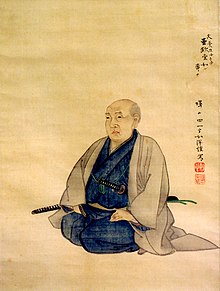Aōdō Denzen | |
|---|---|
亜欧堂 田善 | |
 Portrait of Aōdō by Endō Denichi | |
| Born | Zenkichi Nagata (永田 善吉, Nagata Zenkichi) c. 1748 Sukagawa, Mutsu Province, Japan |
| Died | June 25, 1822 (aged 73–74) |
| Other names | Aeudoo Denzento[1] |
| Occupation(s) | Painter, copperplate engraver |
| Relatives | Eiji Tsuburaya (descendant) |
Aōdō Denzen (亜欧堂 田善, c. 1748 – June 25, 1822) was a Japanese painter and copperplate engraver. A leading figure in Japanese painting during the late Edo period, he is credited with introducing Western painting to Japan.
Biography
[edit]Early life
[edit]Aōdō was born Zenkichi Nagata (永田 善吉, Nagata Zenkichi) in 1748 in Sukagawa, Mutsu Province (now Fukushima Prefecture), Japan.[2] He was the second son of Sōshirō Nagata, a wealthy farm implement dealer.[3] Upon the death of his father, he helped his older brother, Jokichi, who was a dyer, for a long time. Jokichi had a penchant for painting, and while working in the family business, Zenkichi learned painting from him.
Painting career
[edit]In his painting career, Aōdō employed Western-style painting techniques such as perspective and shading to achieve Western-style copperplate engraving.[2] Adding Edo customs to Shiba Kokan's Western-style landscape paintings, he discovered new landscapes and perfected Western-style landscape copperplate engravings.[2]
Legacy
[edit]Sadaki Ota's Aōdō Denzen Collection, owned by the Sukagawa museum, was declared an important culturally significant in 1986.[2] In 2001, Eiji Tsuburaya biographers cited Aōdō as an ancestor of Tsuburaya, claiming Tsuburaya inherited Aōdō's dexterity.[4][5]
References
[edit]- ^ Shogakukan 2007, p. 8.
- ^ a b c d "須賀川人物伝 亜欧堂田善". Sukagawa City (in Japanese). Retrieved February 14, 2023.
- ^ Ueda et al. 2009, p. 3.
- ^ Matsuda 2001, pp. 10–12.
- ^ Takeuchi & Yamamoto 2001, p. 324.
Bibliography
[edit]- Matsuda, Takehisa, ed. (August 10, 2001). 円谷英二特撮世界 [Eiji Tsuburaya's World of Tokusatsu] (in Japanese). Keibunsha. ISBN 4-7669-3848-8.
- 江戸時代人物控1000 [Edo period person's copy 1000] (in Japanese). Shogakukan. 2007. ISBN 978-4-09-626607-6.
- Takeuchi, Hiroshi; Yamamoto, Shingo, eds. (2001). 円谷英二の映像世界 [Eiji Tsuburaya's Visual World] (in Japanese) (2nd ed.). Jitsugyo no Nihon Sha. ISBN 4-40839474-2.
- Ueda, Masaaki; Tsuda, Hideo; Nagahara, Keiji; Fujii, Matsuichi; Fujiwara, Akira (2009). コンサイス日本人名辞典 [Concise Japanese Dictionary] (in Japanese) (5th ed.). Sanseidō. ISBN 978-4385158013.
External links
[edit]
Well, that’s interesting to know that Psilotum nudum are known as whisk ferns. Psilotum nudum is the commoner species of the two. While the P. flaccidum is a rare species and is found in the tropical islands. Both the species are usually epiphytic in habit and grow upon tree ferns. These species may also be terrestrial and grow in humus or in the crevices of the rocks.
View the detailed Guide of Psilotum nudum: Detailed Study Of Psilotum Nudum (Whisk Fern), Classification, Anatomy, Reproduction